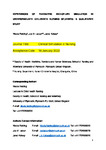Experiences of paediatric end-of-life simulation in undergraduate children’s nursing students: A qualitative study
| dc.contributor.author | Fielding, N | |
| dc.contributor.author | Latour, Jos M | |
| dc.contributor.author | Kelsey, Janet | |
| dc.date.accessioned | 2022-01-16T20:43:53Z | |
| dc.date.issued | 2022-04 | |
| dc.identifier.issn | 1876-1399 | |
| dc.identifier.issn | 1876-1402 | |
| dc.identifier.uri | http://hdl.handle.net/10026.1/18562 | |
| dc.description.abstract |
Background: End-of-life-care (EOLC) simulation is a new concept preparing student nurses for clinical practice. The aim of this study was to explore the experiences of undergraduate children's nursing students participating in simulation of the imminent death of a child. Methods: A sample of 39 third-year children's nursing students participated in an open-ended questionnaire and five students participated in a focus group. Data was analysed using thematic analysis. Results: Four themes were identified. (a) ‘Learning how to communicate in an end-of-life situation’ including challenges faced by participants in communicating with parents. (b) ‘Emotional impact of end-of-life simulation’ demonstrating significant emotional impacts on participants. (c) ‘Value of simulation for teaching end-of-life care’ with all participants reporting the simulation training as useful and providing a positive experience for learning despite the emotive nature. (d) ‘Preparation for practice’ reporting that simulation has prepared students to deliver EOLC in practice. Conclusion: The findings support the use of simulation as a method of teaching EOLC. There is a need to ensure the emotional safety of student nurses engaging in EOLC simulation. | |
| dc.format.extent | 18-25 | |
| dc.language | en | |
| dc.language.iso | en | |
| dc.publisher | Elsevier | |
| dc.subject | simulation | |
| dc.subject | children | |
| dc.subject | nursing | |
| dc.subject | students | |
| dc.subject | end of life care | |
| dc.title | Experiences of paediatric end-of-life simulation in undergraduate children’s nursing students: A qualitative study | |
| dc.type | journal-article | |
| dc.type | Journal Article | |
| plymouth.author-url | https://www.webofscience.com/api/gateway?GWVersion=2&SrcApp=PARTNER_APP&SrcAuth=LinksAMR&KeyUT=WOS:000788059300003&DestLinkType=FullRecord&DestApp=ALL_WOS&UsrCustomerID=11bb513d99f797142bcfeffcc58ea008 | |
| plymouth.volume | 65 | |
| plymouth.publication-status | Published | |
| plymouth.journal | Clinical Simulation in Nursing | |
| dc.identifier.doi | 10.1016/j.ecns.2022.01.003 | |
| plymouth.organisational-group | /Plymouth | |
| plymouth.organisational-group | /Plymouth/Faculty of Health | |
| plymouth.organisational-group | /Plymouth/Faculty of Health/School of Nursing and Midwifery | |
| plymouth.organisational-group | /Plymouth/REF 2021 Researchers by UoA | |
| plymouth.organisational-group | /Plymouth/REF 2021 Researchers by UoA/UoA03 Allied Health Professions, Dentistry, Nursing and Pharmacy | |
| plymouth.organisational-group | /Plymouth/Research Groups | |
| plymouth.organisational-group | /Plymouth/Research Groups/Institute of Health and Community | |
| plymouth.organisational-group | /Plymouth/Research Groups/Plymouth Institute of Health and Care Research (PIHR) | |
| plymouth.organisational-group | /Plymouth/Users by role | |
| plymouth.organisational-group | /Plymouth/Users by role/Academics | |
| dcterms.dateAccepted | 2022-01-16 | |
| dc.rights.embargodate | 2023-2-18 | |
| dc.identifier.eissn | 1876-1402 | |
| dc.rights.embargoperiod | Not known | |
| rioxxterms.versionofrecord | 10.1016/j.ecns.2022.01.003 | |
| rioxxterms.licenseref.uri | http://www.rioxx.net/licenses/all-rights-reserved | |
| rioxxterms.licenseref.startdate | 2022-04 | |
| rioxxterms.type | Journal Article/Review |


